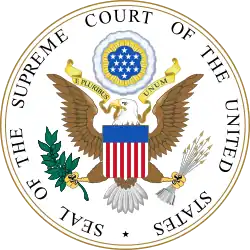Los Angeles County v. Mendez
| Los Angeles County v. Mendez | |
|---|---|
 | |
| Decided May 30, 2017 | |
| Full case name | Los Angeles County v. Mendez |
| Citations | 581 U.S. 420 (more) |
| Holding | |
| Under the Fourth Amendment, there is no "provocation rule" that makes an officer's reasonable use of force unreasonable if the officer provoked the violent confrontation by violating the Fourth Amendment. | |
| Court membership | |
| |
| Case opinion | |
| Majority | Alito, joined by unanimous |
| Gorsuch took no part in the consideration or decision of the case. | |
| Laws applied | |
| Const. amend. IV | |
Los Angeles County v. Mendez, 581 U.S. 420 (2017), was a United States Supreme Court case in which the court held that under the Fourth Amendment, there is no "provocation rule" that makes an officer's reasonable use of force unreasonable if the officer provoked the violent confrontation by violating the Fourth Amendment.[1][2]
Background
The Los Angeles County Sheriff's Department received word from a confidential informant that a potentially armed-and-dangerous parolee-at-large had been seen at a certain residence. While other officers searched the main house, Deputies Conley and Pederson searched the back of the property where, unbeknownst to the deputies, respondents Angel Mendez and Jennifer Garcia (later also Mendez) were napping inside a shack where they lived. Without a search warrant and without announcing their presence, the deputies opened the door of the shack. Mendez rose from the bed, holding a BB gun that he used to kill pests. Deputy Conley yelled, "Gun!" and the deputies immediately opened fire, shooting Mendez and Garcia multiple times. Officers did not find the parolee in the shack or elsewhere on the property.[1]
Mendez and Garcia sued Deputies Conley and Pederson and the County under Section 1983, pressing three Fourth Amendment claims: a warrantless entry claim, a knock-and-announce claim, and an excessive force claim. On the first two claims, the federal district court awarded Mendez and Garcia nominal damages. On the excessive-force claim, the court found that the deputies' use of force was reasonable under Graham v. Connor, but held them liable nonetheless under the Ninth Circuit Court of Appeals's provocation rule, which made an officer's otherwise reasonable use of force unreasonable if (1) the officer "intentionally or recklessly provokes a violent confrontation" and (2) "the provocation is an independent Fourth Amendment violation." On appeal, the Ninth Circuit held that the officers were entitled to qualified immunity on the knock-and-announce claim and that the warrantless entry violated clearly established law. It also affirmed the district court's application of the provocation rule, and held, in the alternative, that basic notions of proximate cause would support liability even without the provocation rule.[1]
Opinion of the court
The Supreme Court issued an opinion on May 30, 2017.[1]
The Ninth Circuit's provocation rule "provides a novel and unsupported path to liability in cases in which the use of force was reasonable". For example, in this case, the Ninth Circuit ruled that the use of force was excessive because the deputies "provoked" the need to use force when they entered the premise without a warrant, even though the use of force was otherwise reasonable under Graham v. Connor because they genuinely believed "a man was holding a firearm rifle threatening their lives".
The Supreme Court ruled that excessive force claims should be assessed based on the totality of circumstances.
Subsequent developments
References
External links
This article incorporates written opinion of a United States federal court. As a work of the U.S. federal government, the text is in the public domain.